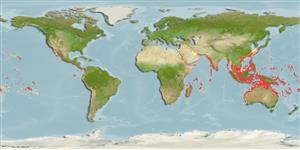>
Eupercaria/misc (Various families in series Eupercaria) >
Scaridae (Parrotfishes) > Scarinae
Etymology: Scarus: Greek, skaros = a fish described by anciente writers as a parrot fish; 1601 (Ref. 45335).
Environment: milieu / Klimaatzone / Diepte / distribution range
Ecologie
marien; brak water rifbewoner; diepte 1 - 90 m (Ref. 89642). Tropical; 31°N - 35°S, 21°E - 77°W
Indo-West Pacific: Algoa Bay, South Africa and Red Sea (Ref. 5490), Persian Gulf (Ref. 80050) to Rapa and Ducie islands, north to southern Japan, south to Perth, New South Wales. Likely in Seychelles (Ref. 1623). Eastern Pacific: Gulf of California to Ecuador (Ref. 5227). Lessepsian migrant to the Mediterranean. First of Family Scaridae (Ref. 45081).
Lengte bij maturiteit / Grootte / Gewicht / Leeftijd
Maturiteit: Lm ?, range 49 - ? cm
Max length : 75.0 cm TL mannelijk / geslacht onbekend; (Ref. 90102); common length : 30.0 cm TL mannelijk / geslacht onbekend; (Ref. 55763); max. gerapporteerde leeftijd: 13 Jaren (Ref. 42001)
Dorsale stekels (totaal) : 9; Dorsale zachte stralen (totaal) : 10; Anale stekels: 3; Anale zachte stralen: 9. This species is distinguished by the following characters: median predorsal scales 6-8 (usually 7); 3 scale rows on cheek, 1(6-7), 2(6-9), 3(3-5); pectoral-fin rays 13-15 (occasionally 15); terminal male usually with 2 conical teeth on side of upper dental plate (female without), with lips mainly covering the plates; caudal fin rounded in small female, with prolonged lobes in large adult. Colour of male dark reddish brown anteriorly with a bright green dot at top end of line from mouth through eye to top of opercular opening; female red on head, belly and fins, side with wavy black and white stripes, and dark green bands around the mouth and eye (Ref. 9793, 90102).
Body shape (shape guide): fusiform / normal; Cross section: compressed.
Adults inhabit lagoon and seaward reefs (Ref. 1602), in slopes and drop-offs (Ref. 48636), often solitary but may sometimes occur in small groups (Ref. 9710, 48636). Males common in atolls where they live mainly around the inner and outer edges of barrier reefs at depths of about 30 ft; females prefer deeper habitat (Ref. 4821). Small juveniles in groups are found inshore on algae reef habitat (Ref. 9710, 48636) and sometimes enter silty, murky environments (Ref. 5490). Feed by scraping algae from rocks and corals (Ref. 5227). Are protogynous hermaphrodites (Ref. 55367). Caught with nets and other types of artisanal gear. Marketed fresh (Ref. 5284). In the Hong Kong live fish markets (Ref. 27253). Minimum depth reported from Ref. 90102.
Levenscyclus en paargedrag
Maturiteit | Voortplanting | Paaien | Eieren | Fecunditeit | Larven
Oviparous, distinct pairing during breeding (Ref. 205). Sex change occurs at 29.0 cm TL and 7 years of age (Ref. 55367).
Parenti, P. and J.E. Randall, 2000. An annotated checklist of the species of the labroid fish families Labridae and Scaridae. Ichthyol. Bull. J.L.B. Smith Inst. Ichthyol. (68):1-97. (Ref. 35918)
Status op de Rode Lijst van het IUCN (Ref. 130435: Version 2025-1)
Gevaar voor de mens
Harmless
Gebruik door de mens
Visserij: commercieel; Aquarium: Commercieel
Tools
Speciale rapporten
Download XML
Internetbronnen
Estimates based on models
Preferred temperature (Ref.
123201): 24.5 - 29.1, mean 28 °C (based on 1802 cells).
Fylogenetische diversiteitsindex (Ref.
82804): PD
50 = 0.5000 [Uniqueness, from 0.5 = low to 2.0 = high].
Bayesian length-weight: a=0.01445 (0.01200 - 0.01741), b=3.03 (2.99 - 3.07), in cm total length, based on LWR estimates for this species (Ref.
93245).
Trofisch niveau (Ref.
69278): 2.0 ±0.0 se; based on diet studies.
Weerstandsvermogen (Ref.
120179): Gemiddeld, minimale populatieverdubbelingstijd 1,4-4,4 jaar (K=0.47; tmax=13).
Prior r = 0.55, 95% CL = 0.36 - 0.83, Based on 1 data-limited stock assessment.
Fishing Vulnerability (Ref.
59153): Moderate to high vulnerability (50 of 100).
🛈
Climate Vulnerability (Ref.
125649): High to very high vulnerability (74 of 100).
🛈
Nutrients (Ref.
124155): Calcium = 25 [14, 42] mg/100g; Iron = 0.629 [0.410, 0.980] mg/100g; Protein = 18.9 [16.8, 20.7] %; Omega3 = 0.0973 [, ] g/100g; Selenium = 25.9 [14.6, 41.5] μg/100g; VitaminA = 34 [10, 113] μg/100g; Zinc = 2.13 [1.50, 2.72] mg/100g (wet weight); based on
nutrient studies.
